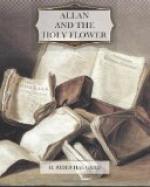“That might be useful,” I said, reflectively, “but go on.”
“I learned that on the western boundary of the Mazitu territory were great swamps; that beyond these swamps was a lake called Kirua, and beyond that a large and fertile land supposed to be an island, with a mountain in its centre. This land is known as Pongo, and so are the people who live there.”
“That is a native name for the gorilla, isn’t it?” I asked. “At least so a fellow who had been on the West Coast told me.”
“Indeed, then that’s strange, as you will see. Now these Pongo are supposed to be great magicians, and the god they worship is said to be a gorilla, which, if you are right, accounts for their name. Or rather,” he went on, “they have two gods. The other is that flower you see there. Whether the flower with the monkey’s head on it was the first god and suggested the worship of the beast itself, or vice versa, I don’t know. Indeed I know very little, just what I was told by the Mazitu and a man who called himself a Pongo chief, no more.”
“What did they say?”
“The Mazitu said that the Pongo people are devils who came by the secret channels through the reeds in canoes and stole their children and women, whom they sacrificed to their gods. Sometimes, too, they made raids upon them at night, ‘howling like hyenas.’ The men they killed and the women and children they took away. The Mazitu want to attack them but cannot do so, because they are not water people and have no canoes, and therefore are unable to reach the island, if it is an island. Also they told me about the wonderful flower which grows in the place where the ape-god lives, and is worshipped like the god. They had the story of it from some of their people who had been enslaved and escaped.”
“Did you try to get to the island?” I asked.
“Yes, Allan. That is, I went to the edge of the reeds which lie at the end of a long slope of plain, where the lake begins. Here I stopped for some time catching butterflies and collecting plants. One night when I was camped there by myself, for none of my men would remain so near the Pongo country after sunset, I woke up with a sense that I was no longer alone. I crept out of my tent and by the light of the moon, which was setting, for dawn drew near, I saw a man who leant upon the handle of a very wide-bladed spear which was taller than himself, a big man over six feet two high, I should say, and broad in proportion. He wore a long, white cloak reaching from his shoulders almost to the ground. On his head was a tight-fitting cap with lappets, also white. In his ears were rings of copper or gold, and on his wrists bracelets of the same metal. His skin was intensely black, but the features were not at all negroid. They were prominent and finely-cut, the nose being sharp and the lips quite thin; indeed of an Arab type. His left hand was bandaged, and on his face was an expression of great anxiety. Lastly, he appeared to be about fifty years of age. So still did he stand that I began to wonder whether he were one of those ghosts which the Mazitu swore the Pongo wizards send out to haunt their country.




